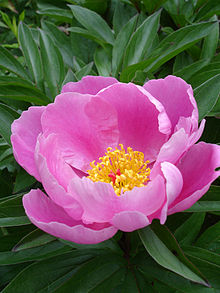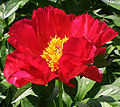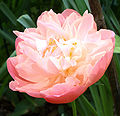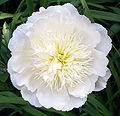- Paeonia lactiflora
-
Paeonia lactiflora 
Wild form of Paeonia lactiflora Scientific classification Kingdom: Plantae (unranked): Angiosperms (unranked): Eudicots (unranked): Core eudicots Order: Saxifragales Family: Paeoniaceae Genus: Paeonia Species: P. lactiflora Binomial name Paeonia lactiflora
Pall.Synonyms Paeonia edulis Salisb.
Paeonia albiflora Pall.Paeonia lactiflora, also Chinese Peony (芍 or 白芍 in Chinese; pinyin: sháo or bái sháo; bái meaning "white"), and common garden peony is a herbaceous perennial flowering plant in the family Paeoniaceae, native to central and eastern Asia from eastern Tibet across northern China to eastern Siberia. It is about 60–100 cm tall with large compound leaves 20–40 cm long. The flower buds are large and round, opening into large flowers 8–16 cm diameter, with 5-10 white, pink, or crimson petals and yellow stamens.
Contents
Background
Chinese Peony is widely grown as an ornamental plant in gardens, with several hundred selected cultivars; many of the cultivars have double flowers, with the stamens modified into additional petals. It was first introduced to England in the mid-18th century, and is the species that has produced most common garden peonies today.[1] It was known as P. albiflora for many years, and as the white peony when first introduced into Europe. There are many colors now available, from pure milk white, to pink, rose, and near red—along with single to full double forms. They are prolific bloomers, and have become the main source of peonies for the cut flower business.[2]
In China, it is less highly valued as an ornamental plant than the cultivars of tree peony Paeonia rockii (tree peony, known as ziban mǔ dān in Chinese) and its hybrid Paeonia x suffruticosa, or mǔ dān (牡丹 ).
It is used as a medicinal herb in traditional Chinese medicine, where it is called 芍药 (pinyin: sháo yào; literally: "Peony Medicine") or 白芍药 (pinyin: bái sháo yào; literally: "White Peony Medicine"). The root is used to reduce fever and pain, and on wounds to stop bleeding and prevent infection. An antispasmodic effect is also recorded in the Japanese pharmacopoeia.[citation needed] The leaves of many cultivars are high in oleanolic and ursolic acid.[3]
Gallery
Notes
- ^ Loewer, H. Peter (1999). Fragrant Gardens. Houghton Mifflin Gardening. pp. 48. ISBN 9780395884928. http://books.google.com/books?id=bBJdIKPiGuMC&pg=PA48&dq=Peony+common+garden&as_brr=3&ei=t7JXSdakD4TOlQT-0ZmXCA&client=safari#PPA48,M1.
- ^ Halda, Josef J.; James W. Waddick (2004). The Genus Paeonia. Timber Press. pp. 196–205. ISBN 9780881926125. http://books.google.com/books?id=mDLASKInbjgC&pg=PA196&dq=Peony+common+garden&lr=&as_brr=3&ei=obNXSaPWNoL4lQSq3q3XAw&client=safari#PPA202,M1.
- ^ Zhou C, Zhang Y, Sheng Y, Zhao D, Lv S, Hu Y, Tao J.,"Herbaceous Peony (Paeonia lactiflora Pall.) as an Alternative Source of Oleanolic and Ursolic Acids." Int J Mol Sci. 2011;12(1):655-67
References
- PubMed abstracts: Palbinone, a novel terpenoid from Paeonia albiflora
- Plants for a Future: Paeonia lactiflora
External links
Categories:- Peonies
- Flora of Tibet
- Flora of Siberia
- Flora of China
- Garden plants of Asia
- Flowers
Wikimedia Foundation. 2010.






